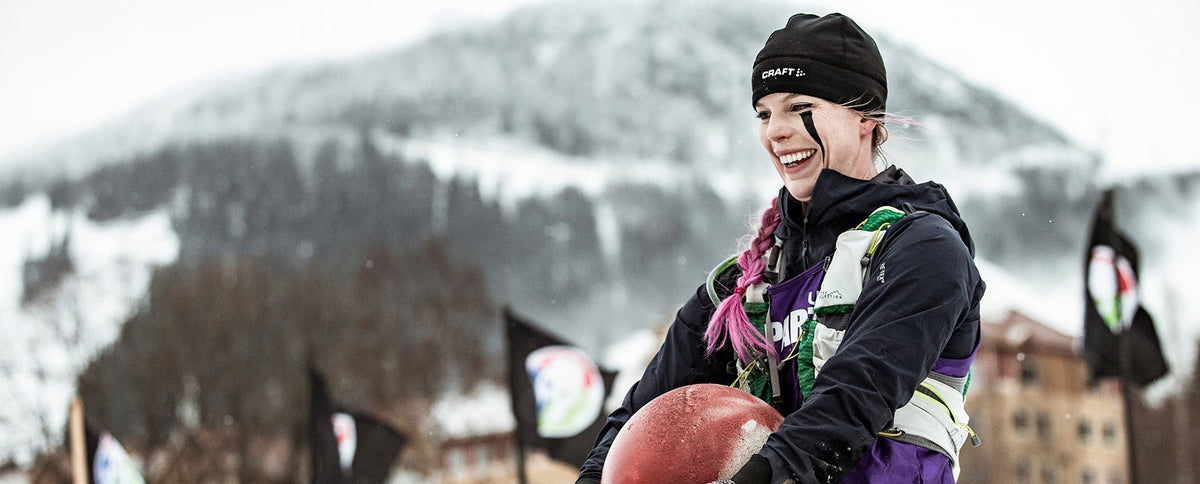Eat Like Spartan Ultra World Champion Morgan McKay for a Week

Everybody wants to know how the highest-level athletes fuel their bodies for elite competition. What are their go-to foods? Which diets do they rely on for max performance? How do they strategically break up their day? In Eat Like a Champion, a recurring franchise, we give you the inside scoop on our professional athletes' dietary habits: what they're eating, why they're eating it, and when they're eating it. Follow their lead and fuel like a champion.
It’s no shock that an athlete who not only survives, but thrives in a 24-hour endurance race has her nutrition dialed in. What might be surprising about 2018 Spartan Ultra World Champion Morgan McKay is how simple her nutrition has actually become.
The results that the professional OCR athlete seeks from nutrition are now less motivated by being lean overall and looking race ready, and more so by simply feeling energized.
“I would now describe my nutrition as clean, balanced, flexible, and intuitive,” McKay said.
From the Name Diets to the Basics: McKay’s Journey
The path to McKay’s current “less restrictive” approach went through experimenting with diets like Paleo, Zone, vegan, and keto.
“I have tried them all,” McKay said. “They do work, but I’ve found what serves me best as an athlete is less restriction than what you get with a specific methodology.”
McKay offered up a deep dive into veganism as an example.
“I was vegan for about eight months,” she said, talking about an approach made famous in the endurance world by vegan ultra-runner Scott Jurek of Born to Run fame. “In general it felt good. But it was hard and restrictive.”
Related: Meet Our Raw Vegan Racers (And Hear Why They Drink Seawater Daily)
In addition to the difficulty of practicing a diet devoid of foods like meat, fish, dairy, and eggs, McKay reported that the vegan life didn’t mesh well with her training and racing. This disconnect was a common problem for her, regardless of the regimen's methodology.
“For me, something was missing," McKay said. "I felt a little bit hollow. Although the diet might have helped me get lean and look good, I would struggle with feeling tired.”
Coming to this realization led this Spartan Champion to her current approach to fueling up: Eat clean, but allow energy needs to be your guide.
“Now I make meal choices based on what my activity is going to demand of me,” she said.
Race-Day Energy (and Stomach Management)

Without hard-edged restrictions bearing down heavily on her diet, McKay solved a problem she often encounters on race day. When following a methodology that forbids eating the kinds of carbs an athlete typically has access to during an event, McKay smacked into race-day-related digestion issues.
“My stomach just couldn’t handle things like gels and bananas,” she said.
This brand of problem becomes magnified the longer an athlete is on the course. In a 24-hour race — as a vivid example — you are combining intense stress on your internal organs with VAST energy demands. The stomach can become pickier when the muscles are screaming for fuel. The upshot? Training the stomach is just as important as training the muscles.
Related: Is It Bad to Change Your Diet Before a Race?
McKay’s more flexible diet permits her to include fast-carb foods on her endurance training days. This is usually on Saturday, when she logs three or more hours of training. Throughout those hours, McKay purposely relies on the same food products she’ll be consuming during an actual event, effectively enabling her to train her digestive system through simulation.
This approach has helped the Spartan Champion tune in to what her body really needs.
“I adjust my nutrition based on my body signals and level of activity." McKay said. “Because I don’t limit or restrict anything from my eating, I can adjust my nutrition based on those signals I’m getting from my body.”
A Key Piece of Advice from the Champion Herself
In addition to being an elite OCR athlete, McKay is also a coach. So, she’s accustomed to a variety of nutrition questions. Regardless of whether an athlete follows her lead – a primarily clean, whole-foods diet with built-in flexibility – McKay consistently offers one piece of advice to athletes, no matter what nutritional path they follow: After making a significant life change, give it a few days before you decide whether to quit or carry on.
In the days immediately following that change — whether it’s getting off sugar or taking on something like intermittent fasting — it takes time for your body to adapt.
“No matter what, you’ll probably feel pretty lousy at first," McKay said. "Give it a week before you make any final judgement on how it’s working for you.”
Sunday Through Friday: Clean, Simple, Fast, Flexible
McKay’s nutrition is designed to fit into a hectic life and serve her needs as an athlete. The elite athlete said she eats pretty much the same every single day.
Post-Fat/Pre-Workout: Ignite the Fat Oxidation
McKay’s first workout of the day is a functional, metabolic conditioning workout she leads live online at 7 a.m. Before the workout, she drinks a cup of black coffee.
Related: These At-Home Tabata Workouts Will Completely Light You Up
“I drink [black coffee] for the fat-burning effect,” she explained. “This follows a 12-hour fast, so it kicks up my ability to use fat for fuel right before exercise.”
Breakfast

After the workout, McKay drinks two cups of water. And about a half hour later, her breakfast looks like this:
- 3 scrambled eggs
- 2 pieces of bacon
- Half a bagel with peanut butter
- Another coffee with two creams
Mid-Morning Snack
In addition to being an elite endurance athlete and a professional coach, McKay works a full-time day job in marketing. Her mid-morning snack is fruit, because according to McKay, she "doesn’t have time to be fancy about it.”
- Banana, three small oranges, or one apple
Lunch
As far as lunch goes, McKay said she basically cycles through lean meats such as turkey, fish, chicken, and extra-lean beef.
- Lean meat with veggies
Afternoon Snack

- 80 to 100 grams of oatmeal
- 1 scoop of whey protein
- A shake
McKay's “Magic Shake," as she calls it, is a mix of multiple supplements — branch-chain amino acids, glucosamine, vitamin C, MCT oil, collagen, and apple cider vinegar — with green veggies like kale. McKay said she adds the apple cider vinegar per a medical doctor’s advice.
Related: Should You Be Taking Pre-Workout Supplements?
“I’m not a nutritionist, so it’s advice I received," she said. "But it’s my understanding it’s good for stomach health.”
Dinner
- Generally lean meat, veggies, and a carb choice
McKay said she usually leans on her intuition when it comes to choosing carbs.
“For example, it could be a sweet potato or it could be rice," she said."I listen to what my body is craving. These are the carbs that will help me recover faster.”
For vegetables, McKay prefers greens like kale, spinach, Brussels sprouts, and the like. The occasional tomato also makes an appearance in her plans.
Saturday: McKay’s Endurance Training Day
While McKay’s diet varies very little Sunday through Friday, Saturday is a whole different ball game (or race, as the case may have it).
“On Saturday, my eating is a lot less structured,” she said. “I eat a greater variety of foods based on how I feel. I like to pick foods that are denser in calories and will simulate foods I will eat during a race. This way I know what works for my body months before I compete.”
Breakfast
- 100 grams of oatmeal with a scoop of peanut butter
- 50 grams of mixed berries
- 1 scoop of whey protein powder
Mix it all together and, according to McKay, "it tastes like cake!"
Inter-Workout
During her Saturday training, McKay will eat foods (gels, bananas, etc.) that she might eat during a race. She will also switch up her sports drink to expose her stomach to what she might consume during a race (even if it's weeks or months down the road).
Related: Eat These Foods During Your Next Ultra Race
Post-Workout
It’s all about recovery.
- Banana or protein recovery shake
- Homemade protein balls made from oatmeal, peanut butter, protein powder, honey, and chocolate chips
Lunch
McKay's lunch continues to focus on consistent recovery. Her go-to is generally high in calories, because she's usually super hungry by lunchtime — another example of properly listening and responding to your body's energy needs.
- Half a pizza
- Magic Shake
Related: Drink This Protein Smoothie to Recover Like a Spartan Pro
Dinner
- Chicken and rice
“And if I am still hungry, the other half of the pizza,” McKay added with a smile.











